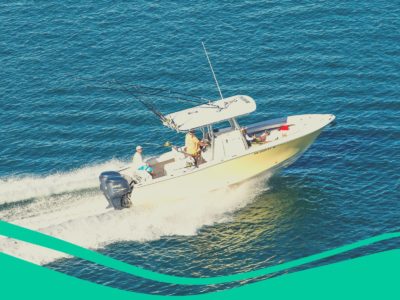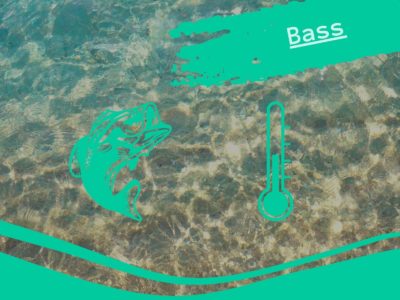Trolling is one of the best ways to get a bite from stripers. They are a hard-fighting fish, and they have a high tolerance for pain. That means that they can be very challenging to catch.
How to go about choosing the best trolling speed for stripers is a topic that comes up a lot. And with good reason: it’s important to know how to do it right if you want to land a striper!
The right trolling speed can help you catch more striped bass and have a more productive day on the water. And isn’t that what we are all looking for after we’ve gone to effort of launching our boat?
If you’ve found yourself getting bored waiting for a striper to bite, one reason might be because you’re humming along too fast in your boat to get the fish interested.
Speed is everything!
Let me run through how to choose the right speed so you can go home with more stripers in your cooler, and less frustration!
Table of Contents
The Best Trolling Speed for Stripers
When trolling for stripers, you want to choose a speed that gives you the best chance of catching one.
When you are fishing in freshwater, try trolling at speeds between 2.5 and 3.5 miles per hour. This is a good range because it’s slow enough that the fish will be able to see your lure, but fast enough that it doesn’t get too far away from them before they can react and bite.
PRO TIP: In freshwater areas try trolling speeds between 2.5 and 3.5 miles per hour
When you are fishing in saltwater, try trolling at speeds between 2 and 4 miles per hour. There are plenty of different fish in the ocean and stripers have the chance to go after a wider range of prey who move at a wider range of speeds than they do in freshwater lakes. So you can imitate the different speeds of these saltwater fish.
PRO TIP: Out on the ocean a wider range of trolling speeds will be most effective, between 2 and 4 miles per hour
You can also target stripers with a slow troll, but I have found that it’s not as effective as when you troll between 2.5 and 3.5 miles per hour. This really is the best trolling speed for catching more stripers.
Slowing your Motor’s Trolling Speed for Stripers
Slowing down a boat is a pretty basic task for most people, but if you can’t get your main motor down low enough to troll for stripers then here are some extra things you can do to drop that speed.
- Use a 5 Gallon Bucket: Tie a bucket to a rope, tie the rope off on your boat, and chuck that bucket overboard! The drag created by the boat towing a bucket behind you will slow the boat down quite a bit. It will often knock off about 0.5 to 1 mph from your speed. This is my go to method when the boat I am on will only drop to 4mph.
- Change Propeller: If you’re having trouble slowing down your boat, changing the propeller may do the trick! It’s not just about how fast your boat moves—it’s also about how much drag there is on the water behind it. That’s why changing the propeller can help slow down your boat more quickly than anything else!
- Drop a Trolling Plate: If you’re going out fishing in deep waters where there aren’t many obstacles but still want some control over how fast your boat moves through the water, then using a trolling plate can help adjust how fast or slow it goes. The plate sits below the surface of the water and adjusts itself based on how deep or shallow the water is around you. The deeper it goes, the slower your boat moves; the shallower it gets, the faster your boat goes.
- Buy a Kicker Motor: The kicker motor is another great way to slow down your boat if none of these other methods work for you! You’ll want to make sure that you have a high-quality one though, and they can be pretty expensive. If you’re looking to save money on your boat, then this might not be the best option for you!
Striper Rigs to use when Trolling
Remember, stripers are attracted by bright colors and movement so put on a bright colored lure that will stand out against the water’s background. Also make sure that your lure moves well in the water—it should have some weight so that it can move freely on its own without needing too much effort from you.
You might also want to consider using an umbrella rig or swimbait when trolling for stripers. I have found these types of lures to attract more bites from striped bass more often than other kinds of lures do!
How to Troll Umbrella Rigs for Stripers
Trolling umbrella rigs for stripers is one of the most popular ways to catch these fish. The umbrella rig is a long line with a series of hooks attached to it, which are baited with different types of lures and attractors. The umbrella rig allows you to cover a large area of water with your bait and helps you get more bites from the stripers.
To troll an umbrella rig, start by setting up your boat near the shoreline and dropping your anchor in about 20 feet of water. Next, tie on an umbrella rig and make sure you have plenty of leader material between each hook so that they don’t snag on rocks or other debris while they’re being cast out into deeper water where stripers tend to be found during certain times of year depending on where you live.
For example, if you’re fishing in North Carolina then try using 30 pound braid with 50lb fluorocarbon leader material between each hook so that nothing gets tangled up when casting into deeper waters where there may be more snags than what’s normally found closer towards shoreline locations
How to Troll Swimbaits for Stripers
Trolling swimbaits for striper is an awesome way to catch these powerful fish. The best part is, it’s not difficult at all—you just need the right bait, and a little patience.
You can use swimbaits for trolling in both freshwater and saltwater. They’re most effective when fishing from a boat, but you can also troll them from shore if you have enough line out.
Stripers are famous for their ability to dig deep into the water column, so they might not be as easy to catch as other species of fish. But if you use the right bait, they’re actually pretty easy to catch!
The first thing you’ll want to do is find a good swim bait that matches your region: walleye minnows in northern lakes; bluegill in southern lakes; shad-like baits in coastal regions; and live shrimp along the Gulf Coast. You’ll also want to keep an eye out for what’s working for other fishermen in your area (and don’t forget about using your own sense of smell).
In freshwater, the best technique is to set your depth at 2-3 feet and run your swimbait along the bottom, keeping it in contact with the bottom as much as possible. If you’re using bait that has treble hooks, be sure to use a soft plastic squid or other small baitfish imitation to help protect the hook points from being damaged by hitting rocks or gravel.
In saltwater, most anglers prefer to troll between depths of 20 feet and 80 feet. When trolling between these depths in saltwater, try adjusting your speed so that your swimbait drifts slowly and doesn’t create much wake on the surface—this will help keep it in front of more fish.
The Last Cast
Striped Bass are notorious for being a picky fish, and they don’t like to bite unless they have to. But if you know how to get their attention and keep it, you’ll have them on the line in no time.
When you’re out on the water, the rule of thumb is to keep your trolling speed between 2.5 and 3.5 mph. In saltwater, feel free to pick up the pace—troll at 3-4 mph if you’re looking for a big catch and have been having some success that day. Otherwise knock it back down and go closer to 2mph.
Remember stripers like to school together. So when you’ve made a hit turn that boat right back around and troll straight back through the area. Keep working that school until you’ve got all the stripers you’ll need!
Editor’s Picks



